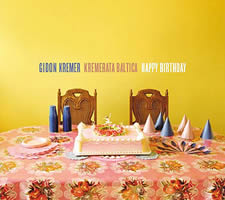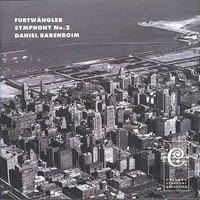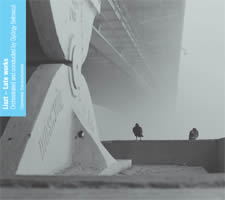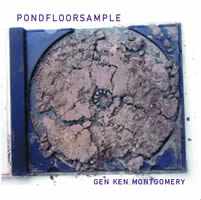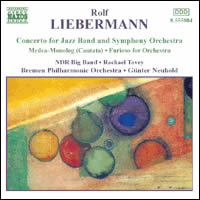Things That Are Not Quite What They Seem
|
Grant Chu Covell [April 2003.]
Gidon Kremer / Kremerata Baltica: Happy Birthday: Alfred SCHNITTKE: Polka (1979); Peter HEIDRICH: “Happy Birthday” Variations (1994); Vato KAKHIDZE: “Blitz”Fantasy (1999); Joseph GHYS / François SERVAIS: Variations Brilliantes et Concertantes sur l’air “God Save the King” (ca. 1850); Peter TCHAIKOVSKY: Elegy (1884); Teddy BOR: McMozart’s Eine Kleine Bricht Moonlicht Nicht Musik (1981); Franz WAXMAN: “Auld Lang Syne” Variations (1947); Ladislav KUPKOVIC: Souvenir (1971). Gidon Kremer (violin), Ula Ulijona (violin), Marta Sudraba (cello), Vato Kakhidze (voice, synthesizers), Louis Lortie (piano). Nonesuch 79657-2 (http://www.nonesuch.com/). Happy Birthday is an odd but pleasing assortment. The music is performed with a flair and the best of intentions. Schnittke’s wry Polka and Tchaikovsky’s mellow Elegy, offerings that would bring relief to other collections, are here the most serious works. Gidon Kremer and the Kremerata Baltica have thwarted expectations. Humor in music is a delicate business. Everybody involved — composer, performer and audience — must be familiar with a library’s worth of background in order to savor a moment-long gag. I enjoy a good joke as well as the next fellow, but really, Heidrich’s “Happy Birthday” Variations is awful. Either Heidrich has no ear or training, or else audiences and musicians are dumber than I care to think. I’ve been in a room when this was played and was astounded by how presumably intelligent musicians ate up this silliness. Variations in the styles of Haydn, Mozart, Beethoven, Brahms, Schumann and Dvorak force the familiar tune into uncomfortable postures. A Slavonic “Happy Birthday” over an accompaniment similar to Dvorak’s American Quartet is quite simply embarrassing. Worse is the absence of appropriate harmonies in the Haydn, Mozart, and Beethoven variations. Haydn, famous for his sense of humor, would never have used such chord progressions or ornaments, nor would Mozart. Yes, there is the old joke about all of Haydn’s string quartets being concertos for the first violin with the three remaining strings taking the cello part, but Haydn was cleverer. The Beethoven variation is in the minor, as if that’s all it takes to mimic Beethoven. The five additional variations in generic styles (Polka/Valse, “im Stil von Filmmusik,” Ragtime, Tango, Czardas) are much better. Enough of the Heidrich. On to the rest. Vato Kakhidze’s intriguing “Blitz” Fantasy doesn’t fit into any category. Kakhidze vocalizes and plays synthesizer, and there are moments, such as at the start of the Fantasy’s second movement (Allegretto) and the fourth (Allegro), that make me wonder whether we wandered into Uri Caine’s Goldberg Variations or if this fell off the Kronos’ recent (and superb) Nuevo disc. Kremer and cellist Marta Sudraba fly through a boisterous performance of Ghys / Servais’ Variations Brilliantes et Concertantes sur l’air “God Save the King.” The work’s charm comes from hearing the anthem played in a virtuosic context and with passion. Teddy Bor’s McMozart’s Eine Kleine Bricht Moonlicht Nicht Musik combines Eine Kleine with all sorts of other tunes in a brisk pastiche. It’s short (3:21) and takes itself a bit too seriously. Franz Waxman’s “Auld Lang Syne” Variations is the keeper. According to rumor, Jascha Heifetz, William Primrose, Gregor Piatigorsky and Waxman premiered this at a New Year’s party in Los Angeles. Waxman obviously had an ear and knew his way around the repertoire. Scored for piano quartet (piano, violin, viola and cello), “Auld Lang Syne” is woven musically and entertainingly across quotations of Mozart (Eine Kleine), Beethoven (Moonlight Sonata, Violin Concerto), Bach, Shostakovich and Prokofiev. Why is this better than the Heidrich? This is good music whether or not you know or recognize the underlying allusions, and all four instruments take part in the variations. The program closes with Ladislav Kupkovic’s Souvenir. Like a slapstick vaudeville sketch, the solo violin doodles over the same perpetually repeated accompaniment. Kremer is excellent here. Kremer has put together this type of collection before. The Encore! disc that accompanied the big Philips Lockenhaus collection (Phillips 432 252-2) contains 11 light and humorous pieces by Cage, Kreisler, Martinu, Shostakovich, Leopold Mozart, et al. Mr. Bor, called “Professor” on this hard-to-find 1992 disc, is represented with a genial Double Concerto for Swing Trio (two violins and bass) that mingles bluegrass and Bach. The Kupkovic Souvenir appears in a version for violin, accordion and piano. We hear the Lockenhaus audience responding, which makes the musical jokes easier to follow. With this Nonesuch disc, the at-home audience has to figure out all the jokes by itself. Fittingly, the CD’s cover shows a table set for a birthday party with no guests in sight.
Wilhelm FURTWÄNGLER: Symphony No. 2 (1945). Chicago Symphony Orchestra, Daniel Barenboim (cond.). Teldec 0927 43495 2 (http://www.warnerclassics.com/). Back in college, I remember part of a late night spent listening to a friend’s worn cassette copy made from one of Furtwängler’s own recordings of his Second Symphony. (I think I savored a cassette of Peter Serkin’s flamboyant and vigorous account of Beethoven’s Hammerklavier on fortepiano the same evening.) I was astonished by the symphony’s flagrant debt to Bruckner and didn’t trouble to listen past the first movement’s exposition. But now, years later, with this luxuriant recording from the Chicago Symphony Orchestra under Daniel Barenboim, I can’t get enough of the work. Written in 1945 during the conductor’s last-minute exile to Switzerland where he waited to be cleared of charges of complicity with the Nazis, the Second Symphony is huge in scale (four movements straddling two discs at 81:68), and is a resolutely Romantic product suggesting a different time and place. The symphony’s opening movement, a classic sonata-allegro form writ large (just barely exceeding 23 minutes), really gets me going. It opens with a questioning passage in bassoons and clarinets soon answered by a descending scale in the strings: The curtain rises on a brooding sea. A second subject, momentarily in the sunny major, sweeps out of the orchestra with a pattern of Bruckner-like sequences, thence to the climax. Some of the transitions are a bit abrupt, especially at the end of the first movement, and the third movement closes too quickly, but Furtwängler does know a thing or two about pacing and compensatory orchestral colors. Very few composers in the 1940’s could have written as convincing a large-scale essay. The middle two movements comprise an odd fit, suggesting that they were written earlier. The second movement is a meandering Andante whose themes remind one more of Brahms than of the opening movement’s Bruckner — a mellower overall mood and a bit more chromatic. I had expected something more sinister or carefree in the third movement wherein the first movement’s gravity doesn’t quite fly disguised as a scherzo. Were the symphony’s mood meant to be tragic, moments of levity would have provided relief. Oddly, the middle two movements make me crave Tchaikovsky, whose Fourth and Sixth Symphonies demonstrate his skill at balancing solemnity and levity. The last movement returns to Brucknerian expansiveness with a 30-minute Adagio. There are moments, such as an orchestral outburst just before the five-minute mark, which suggest the bittersweet twilight of late Strauss. Elsewhere, Bruckner-like moments return in full force. After passages that soar through a tour of Germanic Romanticism, we arrive at a rousing heroic fanfare. What a pleasure to hear the Chicagoans sounding so fine! There are many passages where the brasses get to rise, and they meet the challenge wonderfully. This anachronistic music could have been played halfheartedly and insincerely, but not so with the Chicagoans. Furtwängler’s 1953 live and dreadful mono recording on Orfeo C 375 941 B with the Vienna Philharmonic is practically unlistenable. Barenboim’s tempos are nearly identical, though Furtwängler’s reading seems brisker and more businesslike. (The Orfeo disc clocks in at 80:01. Would someone tell me how they can fit this all on one CD?) Interestingly, I don’t find the central two movements as unsatisfying in Furtwängler’s own account. Perhaps Barenboim and the Chicagoans’ perfectionism exposes those movements’ weaknesses. All three of Furtwängler’s symphonies have come out on CD at one time or another. A complete cycle on Marco Polo has drifted out of print. This is a definitive performance and recording, and should help elbow Furtwängler’s music into the repertoire.
Franz LISZT arr. György SELMECZI: Csárdás obstiné, Quatre valses oubliées, Hungarian Historical Portraits, Csárdás macabre. Camerata Transylvanica, György Selmeczi, (cond.). Budapest Music Center Records BMC CD 060 (http://www.bmcrecords.hu/). Distributed in the US by Qualiton (http://www.qualiton.com/). Orchestrating Liszt’s piano works is not unusual. At Liszt’s request, Joachim Raff orchestrated several tone poems and improved the scoring of the piano concertos. For this program, composer / conductor György Selmeczi, who orchestrated 13 late piano works, does nothing that Liszt (or Raff) would likely find objectionable. The pieces date from 1881-85, and in them Liszt broke away from traditional Romantic forms and harmonies. This music is a bit peculiar and gently uncompromising. The program opens and closes with two tiny csárdás, austere and almost postmodern in Selmeczi’s spare instrumentation. The first, Csárdás obstiné, a 3:34 oddity, has practically no tunes or melodies. The violins balance elegantly against a manic solo bass in an incessant repetition of gestures and scale patterns leading to a central section that vainly tries to spin a tune. The opening nonmaterial returns and drops into an ironic and perky coda. The final Csárdás macabre is more coherent. When events become a directionless motor-accompaniment, Selmeczi cleverly chooses an instrumentation suggestive of Weill. Liszt was definitely capable of such aphoristic and fragmentary statements in his old age. Realize that his life spanned a great part of the 19th century (1811 to 1886), and that he outlived his son-in-law, the anti-aphoristic Richard Wagner. In between the csárdás are a set of four waltzes and seven portraits. In the Quatre valses oubliées, Liszt reflects upon the form much as Sibelius and Ravel did in their own time. Harmonies in the first waltz justify Selmeczi’s choice of Valse Triste-like string colors. Foreshadowing Ravel’s paeans to the waltz, Liszt interweaves different melodies in something like a parody. The seven Hungarian Historical Portraits are serious evocations of historical figures clothed as miniature tone poems. Remember that some of the tone poems, for example, the thrilling Mazeppa, began as piano works. Compared to the disc’s other pieces, the Portraits offer fewer surprises. The Camerata Transylvanica is a fine chamber orchestra. There are moments when Selmeczi makes them sound like a café orchestra, with wind and string solos revealing confident professionals. There is more to Liszt than the Liebesträume, as this wistful, delightful program shows. Late Liszt needs more champions. Selmeczi accepts the challenge most admirably.
“Pondfloorsample.” Gen Ken MONTGOMERY: Various compositions. XI Records XI 126 (http://www.xirecords.org/). Available at Forced Exposure (http://www.forcedexposure.com/) and Anomalous Records (http://www.anomalousrecords.com/). Ten seconds would tell you if this is your thing. Take the third track, at 19:26, on the second CD, The Aquarium Fishtank Symphony (1999): One hears an aquarium pump, a fish tank with plastic fish (?), a toy sewing machine, an eggbeater, and an ice-crushing machine — discarded, noisy equipment amplified and in continuous operation. This two-CD set consists largely of domestic-noise documentaries (laminators, radiators, birds, bathtub drains). One doesn’t put this on, kick back with a martini and luxuriate in the sounds. The end-user is advised to play one CD through speakers and the other via headphones, or drive around while listening, or listen outside an open window, and so on and on. Remember those folks who claimed they could tell what was on an LP by looking at the grooves? While CDs differ in content, they’re otherwise indistinguishable. Montgomery reminds us of the time when noise was an intrusion, by capturing the sounds of quotidian objects never intended as sources of sonic engagement. A bittersweet charm resides in these last gasps of objects at their noisiest just this side of falling apart. As I say, you’ll know straight off whether this is for you. Like Montgomery, I too have recorded my refrigerator and built a piece of music around it, so I’m inclined to approve. The tracks are short and texturally rich. Whatever you may think of this as music, you’ll have to agree that Montgomery does have a knack for recording interesting things. Cage was perhaps the first composer to call attention to the noises around us. Montgomery follows in this tradition, and very nicely, too.
Rolf LIEBERMANN: Furioso (1947); Geigy Festival Concerto (1958); Medea-Monolog (1989); Les Echanges (1964, arr. Siegfried Fink); Concerto for Jazz Band and Symphony Orchestra (1954). Rachael Tovey (sop.); Alfons Grieder (perc.); Simon Nabatov (piano); NDR Bigband; Darmstadt Concert Choir; Bremen Philharmonic Orchestra, Günter Neuhold (cond.). Naxos 8.555884 (http://www.naxos.com/). At first glance, a disc with orchestral and vocal music of less-familiar Swiss composer Rolf Liebermann is probably too esoteric for most. What seems to be a string of curiosities is in fact a well-balanced program of rich and substantial performances. Liebermann blended serialism, that most alienating of contemporary styles, with a popular aesthetic. His music is smartly orchestrated and emotionally effective. Furioso is a short overture in ABA form, the repeating section bold and vibrant, its dominant piano part and massed chords suggesting Gershwin’s Concerto in F, albeit in a serial idiom. Liebermann’s serialism is flavored like Berg’s with its emphasis on triads and short, almost tonal gestures and repeating motives. Geigy Festival Concerto strings together a colorful patchwork of Swiss national tunes culminating in an extended solo on the Basel drum (without benefit of the notes, the Basel drum sounds like a snare drum). Like Furioso, this is a good curtain raiser. The short Les Echanges (arranged by Siegfried Fink) is an occasional work for percussion ensemble arising from Liebermann’s desire to capture the sounds of machines. Anything to do with Medea is hardly family entertainment. Not surprisingly, then, the Medea-Monolog is the most difficult as well as the program’s longest and latest work. Liebermann later used some of the material from this “cantata” in an opera, and in this, it exemplifies Liebermann’s sense of drama and skill at controlling events. This work, which takes a bit more effort to come to grips with, is worth the effort. The most striking music comes last. In the Concerto for Jazz Band and Symphony Orchestra, serialism fraternizes with the Big Band as more than just a clever trick. Liebermann brings together the two worlds in possibly the most amusing serial composition ever. (Babbitt can be fun if you know where to laugh.) Liebermann knows how to make serialism work. The concerto’s row is E F# B D G# Bb F C# Eb A G C, which divides neatly into three four-note chords that lend themselves to a jazz treatment with their open fifths, major sevenths and ninths. The concerto opens with a 12-note string chord which is, yes, the row, but the specific octave of the pitches matches the opening piano gesture, the effect more like an impressionist painting than dissonant. And the concerto’s closing chord, a typical Big-Band bang, stacks up the row like a messy minor-thirteenth chord. The Big-Band sound reminds me of Ellington’s score for Anatomy of a Murder without the added reverb. The concerto’s last movement is a mambo — a serial mambo! Let me say that again, the last movement is a serial mambo, a get-up-off-your-butt-and-dance-around-the-room serial mambo. The concerto’s eight movements alternate classical styles (Introduction, two Scherzos, and an Interludium) with dance movements (Jump, Blues, Boogie-Woogie, and Mambo). Liebermann says: “The Jazz orchestra appears like the ‘Concertino’ of Baroque music, while the symphony orchestra performs accompanying functions as well as tasks of its own between.” The dance aspects are in standard 4/4 time, the symphonic movements hovering around irregular meters: The second scherzo, for example, alternates 7/8, 8/8 and 9/8 measures. The SWF-Sinfonieorchester under Hans Rosbaud premiered the concerto at Donaueschingen in 1954. The performance is to be found on the fourth CD of the massive 75 Jahre Donaueschinger Musiktage 1921-1996 brick (col legno WWE 31899). The recording’s mono sound indicates an accurate and somewhat lively performance. If I read col legno’s notes correctly, Liebermann’s concerto was premiered the same day as Stravinsky’s In Memoriam Dylan Thomas, an incomprehensible juxtaposition. The delirium of the concerto’s closing mambo alone is worth the price of the disc, with the remaining items’ consistent quality summing to a must-have acquisition. A Naxos winner!
Furtwängler, Heidrich, Kakhidze, Kupkovic, Liebermann, Liszt, Montgomery, Schnittke, Tchaikovsky, Waxman
[More Grant Chu Covell, Rambles]
[More
Furtwängler, Heidrich, Kakhidze, Kupkovic, Liebermann, Liszt, Montgomery, Schnittke, Tchaikovsky, Waxman]
[Previous Article:
David Tudor: Performer and Composer of Live Electronic Music]
[Next Article:
Tea and Alchemy]
|
